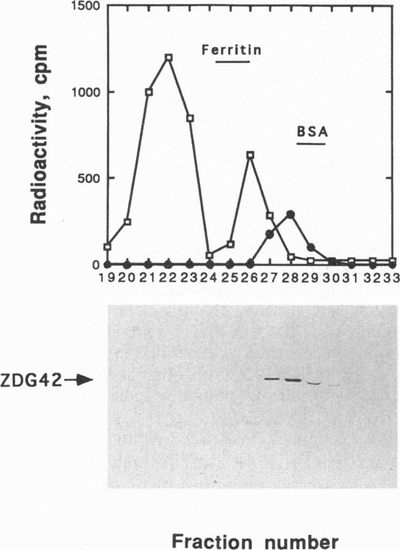Fig. 4
- ID
- ZDB-FIG-080708-15
- Publication
- Semino et al., 1996 - Homologs of the Xenopus developmental gene DG42 are present in zebrafish and mouse and are involved in the synthesis of Nod-like chitin oligosaccharides during early embryogenesis
- Other Figures
- All Figure Page
- Back to All Figure Page
|
Distribution of the zebrafish DG42-like protein in a size exclusion Superose 6 column and fractionation of hyaluronate and chitin oligosaccharide synthase activity. A sample of 300 zebrafish embryos from late gastrula stage were lysed in 200 μl of 1% digitonin buffer and injected into a Superose 6 column equilibrated with 0.1% digitonin buffer as described in Materials and Methods. Fractions 19-33 were used to detect activity of hyaluronate synthase (□) (using labeled UDP-[14C]GlcA and unlabeled UDP-GlcNAc) or chitin oligosaccharide synthase activity (●) (using labeled UDP-[3H]GlcNAc and unlabeled UDP-GlcA) (see Material and Methods). The same methodology used in Table 1 for analysis of HA and chitin oligosaccharides was used here. An aliquot (100 μl) of each fraction was concentrated, resuspended in 1% SDS loading buffer, boiled for 2 min, and applied to a 10% SDS-polyacrylamide gel. After electrophoresis, proteins were transferred to a nitrocellulose membrane and used to develop a Western blot with the anti-DG42 antibody as described in Materials and Methods. The figure at the bottom indicates with an arrow the fractions where zebrafish DG42-like protein was detected (ZDG42). Superose 6 has an exclusion size of 5 x 103 kDa. Blue dextran (2 x 103 kDa), ferritin (440 kDa), and bovine serum albumin (66 kDa) were used to calibrate the column. |

